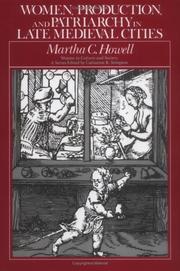| Listing 1 - 1 of 1 |
Sort by
|

ISBN: 0226355039 0226355047 9786612189241 1282189247 0226355063 9780226355030 9780226355047 Year: 1986 Publisher: Chicago : University of Chicago Press,
Abstract | Keywords | Export | Availability | Bookmark
 Loading...
Loading...Choose an application
- Reference Manager
- EndNote
- RefWorks (Direct export to RefWorks)
In this bold reinterpretation of Women's changing labor status during the late medieval and early modern period, Martha C. Howell argues that women's work was the product of the intersection of two systems, one cultural and one economic. Howell shows forcefully that patriarchal family structure, not capitalist development per se, was a decisive factor in determining women's work. Women could enjoy high labor status if they worked within a family production unit or if their labor did not interfere with their domestic responsibilities or threaten male control of a craft or trade.
#SBIB:316.346H22 --- #SBIB:94H0 --- #SBIB:39A72 --- 396 <09> "14" --- Cities and towns, Medieval --- Patriarchy --- -Women --- -Medieval cities and towns --- Human females --- Wimmin --- Woman --- Womon --- Womyn --- Females --- Human beings --- Femininity --- Androcracy --- Patriarchal families --- Fathers --- Families --- Male domination (Social structure) --- Patrilineal kinship --- 396 <09> "14" Geschiedenis van het feminisme. Vrouwengeschiedenis--?"14" --- Geschiedenis van het feminisme. Vrouwengeschiedenis--?"14" --- Positie van de vrouw in de samenleving: arbeid en beroep --- Geschiedenis van Europa: algemeen --- Etnografie: Europa --- History --- Employment --- -History --- -#SBIB:316.346H22 --- -Cities and towns, Medieval --- Women --- Medieval cities and towns --- Employment&delete& --- History of Europe --- anno 500-1499 --- Cities and towns, Medieval. --- History. --- Patriarchaat [Sociologie]. Europa (West-). 1300-1500. --- Femmes. Travail. Europe occidentale. 1300-1500. --- Patriarcat [Sociologie]. Europe occidentale. 1300-1500. --- Vrouwenarbeid. Europa (West-). 1300-1500.
| Listing 1 - 1 of 1 |
Sort by
|

 Search
Search Feedback
Feedback About UniCat
About UniCat  Help
Help News
News